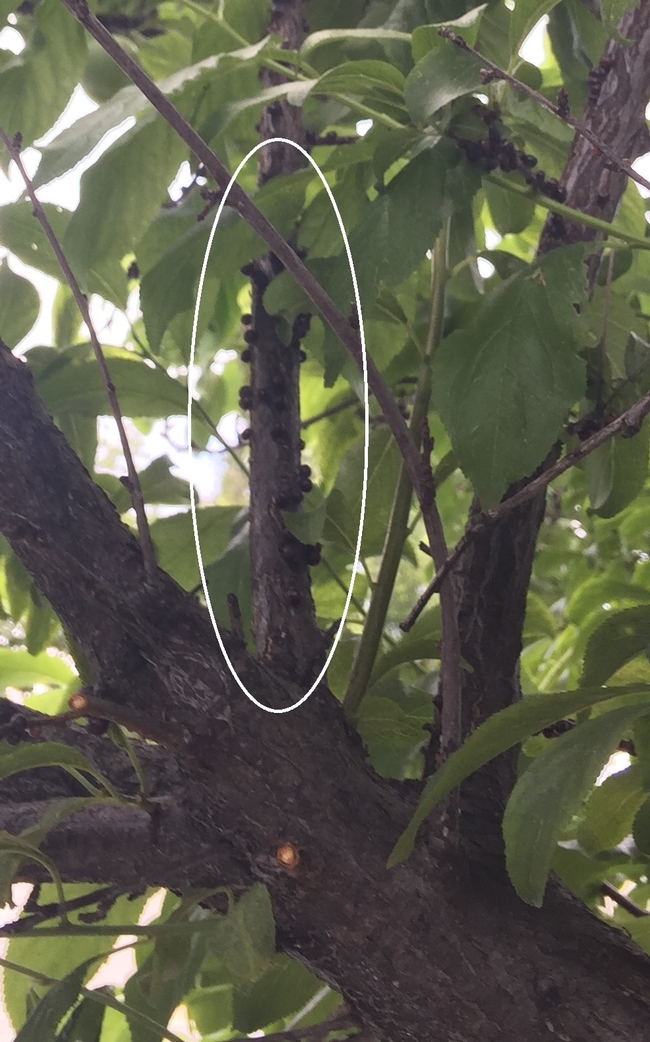Advice from the Help Desk of the
UC Master Gardener Program of Contra Costa County

Response from the Help Desk: Thank you for contacting the UC Master Gardener Program Help Desk, and for resending the photos of your plum tree.
It looks like your tree is heavily infested with Kuno scale (Eulecanium kunoense), which is a common pest in plum trees in the Bay Area. Kuno scale females are almost spherical, resembling beads on stems. They are dark brown and shiny most of the year, turning yellow/orangish during egg production in spring. The nymphs (young scale) are yellow or brown and flattened. They feed on leaves during summer, then go to the branches to overwinter. There is one generation per year. This link will take you information from the University of California on Kuno scale: http://ipm.ucanr.edu/PMG/GARDEN/PLANTS/INVERT/kuno.html. And for more information on scale management in general: http://ipm.ucanr.edu/PMG/PESTNOTES/pn7408.html.
Scales secrete honeydew, a sticky sweet substance that attracts ants. Ants in turn protect the scales from their natural enemies that could help control their population. So, the first thing to do is to control the ants. If the tree's branches touch other plants or structures, prune those branches back so the ants don't have that access route. Use a sticky substance on the trunk to prevent ants' access that way. Wrap the trunk with a collar of heavy paper, duct tape, or fabric tree wrap and coat it with a sticky material such as Tanglefoot. Check the coating every week or so, and stir it to expose new sticky material. If left too long, ants, other insects, and debris will collect on it and obscure the sticky material, allowing access once again. You should also be aware and check to assure that birds occasionally get stuck in this substance trying to eat the trapped ants, etc.
You can also use bait stations to reduce the ant population. Borate-based products seem to be the most effective, as the bait is sugar based and should attract the honeydew-eating ants. Place the station near the base of the tree. Ant baits take a while to work, so it may be a while before you see any results. This link will take you to information on ant management: http://ipm.ucanr.edu/PMG/GARDEN/CONTROLS/antmanagement.html. For more information about ants: http://ipm.ucanr.edu/PMG/PESTNOTES/pn7411.html.
You mus also make sure you are giving good cultural care to your tree, especially with adequate irrigation, to make it more resistant to scale damage. To immediately reduce the scale population, you can prune off the most heavily infested twigs or branches, if that's appropriate for the tree's form. Your pictures look like it is a mature plum that might benefit from a little summer pruning anyway. By opening up the tree, it may increase scale mortality from exposure to heat and predators.
Chemical controls can be used for especially bad infestations. Horticultural oils (narrow-range, superior or supreme), insecticidal soaps, neem oil, or other botanical oils have low toxicity to people and pets, and appropriately applied should have little impact on pollinators and natural enemies. Make sure you follow all instructions on the products' labels, looking especially for which plants not to use the product on. For your plum, spraying with an oil during the dormant season may be the easiest. Foliage spray can be effective to get the nymphs in their crawling stage, but it can be difficult to make sure the product covers all leaf surfaces on a large tree.
To recap: Ant control is the first thing to do. Good cultural care is next. To encourage natural enemies, grow a variety of flowering plants to help attract and support them. Adults of predatory bugs, lacewings, lady beetles, and parasitic wasps live longer, lay more eggs, and kill more scales when they have plant nectar or pollen and insect honeydew to feed on.
It will take several months of efforts (such as controlling ants) or until the next season or longer before scale populations are reduced by biological control. If the level of scales is still intolerable, then consider spraying insecticidal oils to reduce scale populations while conserving natural enemies.
Please let us know if you have further questions.
Good luck with your plum tree!
Help Desk of the UC Master Gardener Program of Contra Costa County (SEH)
Note: The UC Master Gardeners Program of Contra Costa's Help Desk is available year-round to answer your gardening questions. Except for a few holidays, we're open every week, Monday through Thursday for walk-ins from 9:00 am to Noon at 75 Santa Barbara Road, 2d Floor, Pleasant Hill, CA 94523. We can also be reached via telephone: (925) 646-6586, email: ccmg@ucanr.edu, or on the web at http://ccmg.ucanr.edu/Ask_Us/ MGCC Blogs can be found at http://ccmg.ucanr.edu/HortCoCo/ You can also subscribe to the Blog (//ucanr.edu/blogs/CCMGBlog/).